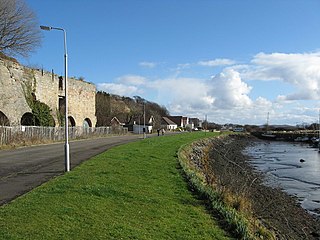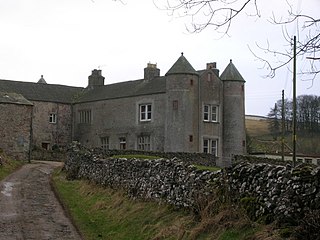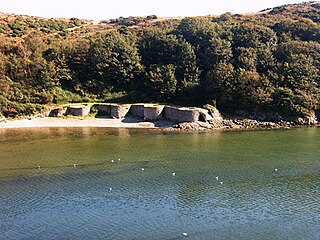
The limekilns at Kiln Park are heritage listed disused limekilns now located in the grounds of a holiday park, Kiln Park, near the village of Penally, Pembrokeshire, Wales. The western set of kilns have a Grade II* heritage listing. [1]

The limekilns at Kiln Park are heritage listed disused limekilns now located in the grounds of a holiday park, Kiln Park, near the village of Penally, Pembrokeshire, Wales. The western set of kilns have a Grade II* heritage listing. [1]
The two sets of limekilns are located on the south side of a private access road to the Kiln Park holiday park, off the A4139 road between Tenby and the village of Penally. The main set of six large kilns (Grade II* listed) are built against the north face of a quarry and are faced with dressed limestone. The exterior wall has five arched entrances and four ventilation windows. A vaulted passageway runs the entire length of the interior, which used to contain a small railway. [1] [2]

The second set of six kilns (Grade II listed) are 250 metres to the east of the main group, following a bend of the park's access road. There are vaulted access spaces between each kiln. [3]
The kilns are 9 metres high and the largest surviving limekilns in Pembrokeshire. [4]
They have been a scheduled monument since 1989. [5]
Limekilns were originally built for the Black Rock limestone quarries circa 1800, but in 1811 the marshland was reclaimed behind Tenby's burrows and the lime industry lost its easy supply of water. The second (current) set of twelve kilns were built circa 1865, accessed by a branch of the Pembroke and Tenby Railway (which had been recently opened). [6]
The later kilns are believed to be connected to Saundersfoot colliery blacksmith, John Nash, a substantial property holder in the area at the time. [1]
The Black Rock quarry was still active till the early 1950s, and the Kiln Park caravan and camping park was developed after World War II, marking the end of industrial activity in the area. [6]
The kilns received a heritage listing in 1996. [1]

A lime kiln is a kiln used for the calcination of limestone (calcium carbonate) to produce the form of lime called quicklime (calcium oxide). The chemical equation for this reaction is

Manorbier is a village, community and parish on the south coast of Pembrokeshire, Wales. The name means the 'Manor of Pŷr'. The community includes Jeffreyston and Lydstep.

Walworth is a central small village with outlying farmsteads, which together constitute a scattered village in the borough of Darlington and the ceremonial county of County Durham, England. It is a civil parish which does not have a church. The population of this civil parish at the 2011 Census was 240. It is situated 2.5 miles (4.0 km) to the north-west of Darlington. The nucleus of the central village is the 16th-century Walworth Castle, which is now a hotel. On the north side of the village, around North Farm, are earthworks signifying a lost settlement, grouped around a barn which was once a chapel.

Penally is a coastal village, parish and community 1 mile (1.6 km) southwest of Tenby in Pembrokeshire, Wales. The village is known for its Celtic Cross, Penally Abbey, the neighbouring St. Deiniol's Well, WWI Practice trenches, and Penally Training Camp. In the community, though nearer to St Florence than Penally, is Carswell Medieval House, a Grade II* listed building.

Carew is a village, parish and community on an inlet of Milford Haven in the former Hundred of Narberth, Pembrokeshire, West Wales, 4 miles (6.4 km) east of Pembroke. The eastern part of the parish is in the Pembrokeshire Coast National Park.

Charlestown is a village in Fife, Scotland. It lies on the north shore of the Firth of Forth, around 1 mile (1.6 km) west of Limekilns and 3 miles (5 km) south-west of Dunfermline.

The Cowell Lime Works, in Santa Cruz, California, was a manufacturing complex that quarried limestone, produced lime and other limestone products, and manufactured wood barrels for transporting the finished lime. Part of its area is preserved as the Cowell Lime Works Historic District, which was listed on the National Register of Historic Places in 2007. In addition to the four lime kilns, cooperage and other features relating to lime manufacture, the Historic District also includes other structures associated with the Cowell Ranch, including barns, a blacksmith shop, ranch house, cook house and workers' cabins. The 32-acre Historic District is located within the University of California, Santa Cruz campus, to either side of the main campus entrance.

Treborough is a small village and civil parish 7 miles (11 km) south of Dunster, lying amongst the Brendon Hills within the Exmoor National Park in the Somerset West and Taunton district of Somerset, England.

Annery kiln is a former limekiln of the estate of Annery, in the parish of Monkleigh, North Devon. It is situated on the left bank of the River Torridge near Half-Penny Bridge, built in 1835, which connects the parishes of Monkleigh and Weare Giffard. Running by it today is A386 road from Bideford to Great Torrington. Weare Giffard is the start of the tidal section of the River Torridge, and thus the kiln was sited here to import by river raw materials for the kiln, the product of which was lime fertiliser for use on inland agricultural fields. The old lime kiln is thus situated between the River Torridge and the now filled-in Rolle Canal built circa 1827 and railway that ran formerly from Bideford to Torrington, opened in 1872 and closed in 1966. The old trackbed now forms a stretch of the Tarka Trail.

Smardale is a small village and former civil parish, now in the parish of Waitby, in the Eden district, in Cumbria, England. In 1891 the parish had a population of 36.

Lydstep Haven, known in ancient times as Lis Castell, is an area in Pembrokeshire, Wales, in the community of Manorbier. Both the beach and caravan park are what is known as Lydstep Haven. Reached via the A4139 from Tenby and Pembroke.

The Holy Island Waggonway was a network of waggonways across the island of Lindisfarne, Northumberland, England.

Grove Lime Kiln is a disused 19th century lime kiln on the Isle of Portland, Dorset, England. It is located close to HM Prison Portland and The Grove village. Owned by the prison service, the lime kiln has been Grade II Listed since 2009.

The Pipers Creek Lime Kilns are heritage-listed former lime kilns at Bonnie Corner Road, Dondingalong in the Kumbatine National Park, New South Wales, Australia. It was built from 1832 to 1840, probably by convicts. It is also known as Bonnie Corner Lime Kilns and Smith's Creek Lime Station. The property is owned by the New South Wales Office of Environment and Heritage. It was added to the New South Wales State Heritage Register on 22 March 2011.

The Solva limekilns are a row of disused limekilns in the harbour of the village of Solva, Pembrokeshire, Wales. The kilns have a Grade II heritage listing.

Chatsworth Calera also called Chatsworth Reservoir Kiln Site is one of the few surviving structures of the early 1800s lime industry. This kiln marked the introduction to California of the European industrial process for vitrifying limestone building blocks which were used in the construction of the San Fernando mission and other mission buildings. The word "Calera" is Spanish for "limestone quarry" or "limekiln". Chatsworth Calera is now located in Chatsworth, Los Angeles, California. in the Chatsworth Nature Preserve. At its peak there may have been up to five kilns at the site run by native Indian laborers. Chatsworth Calera registered a California Historical Landmark No. 911.

Carswell Medieval House is a Grade II-listed historic stone ruin of a medieval tenant farm in the village of Penally, near St Florence in Tenby. Visit Wales describe it as "one of the only buildings of its type still standing in this part of Wales" and an example of "everyday medieval life away from the grand castles often associated with the period."

Grin Low is a hill overlooking Buxton in Derbyshire, in the Peak District. The summit is 434 metres (1,424 ft) above sea level.